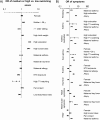Swimming pool attendance, asthma, allergies, and lung function in the Avon Longitudinal Study of Parents and Children cohort
- PMID: 20889905
- PMCID: PMC3081279
- DOI: 10.1164/rccm.201005-0761OC
Swimming pool attendance, asthma, allergies, and lung function in the Avon Longitudinal Study of Parents and Children cohort
Abstract
Rationale: Cross-sectional studies have reported inconsistent findings for the association between recreational swimming pool attendance and asthma and allergic diseases in childhood.
Objectives: To examine whether swimming in infancy and childhood was associated with asthma and allergic symptoms at age 7 and 10 years in a UK longitudinal population-based birth cohort, the Avon Longitudinal Study of Parents and Children.
Methods: Data on swimming were collected by questionnaire at 6, 18, 38, 42, 57, 65, and 81 months. Data on rhinitis, wheezing, asthma, eczema, hay fever, asthma medication, and potential confounders were collected through questionnaires at 7 and 10 years. Spirometry and skin prick testing were performed at 7 to 8 years. Data for analysis were available for 5,738 children.
Measurements and main results: At age 7 years, more than 50% of the children swam once per week or more. Swimming frequency did not increase the risk of any evaluated symptom, either overall or in atopic children. Children with a high versus low cumulative swimming pool attendance from birth to 7 years had an odds ratio of 0.88 (95% confidence interval, 0.56-1.38) and 0.50 (0.28-0.87), respectively, for ever and current asthma at 7 years, and a 0.20 (0.02-0.39) standard deviation increase in the forced midexpiratory flow. Children with asthma with a high versus low cumulative swimming had an odds ratio for current asthma at 10 years of 0.34 (0.14-0.80).
Conclusions: This first prospective longitudinal study suggests that swimming did not increase the risk of asthma or allergic symptoms in British children. Swimming was associated with increased lung function and lower risk of asthma symptoms, especially among children with preexisting respiratory conditions.
Figures


Comment in
-
Pro: swimming in chlorinated pools and risk of asthma: we can now carry on sending our children to swimming pools!Am J Respir Crit Care Med. 2011 Mar 1;183(5):569-70. doi: 10.1164/rccm.201008-1277ED. Am J Respir Crit Care Med. 2011. PMID: 21471055 No abstract available.
-
Con: respiratory risks associated with chlorinated swimming pools: a complex pattern of exposure and effects.Am J Respir Crit Care Med. 2011 Mar 1;183(5):570-2. doi: 10.1164/rccm.201008-1306ED. Am J Respir Crit Care Med. 2011. PMID: 21471056 No abstract available.
-
Some concerns remain about the proposed association between swimming and asthma.Am J Respir Crit Care Med. 2011 Dec 15;184(12):1419; author reply 1419-20. doi: 10.1164/ajrccm.184.12.1419. Am J Respir Crit Care Med. 2011. PMID: 22174114 No abstract available.
References
-
- Goodman M, Hays S. Asthma and swimming: a meta-analysis. J Asthma 2008;45:639–647. - PubMed
-
- World Health Organization. Guidelines for safe recreational water environments [accessed 12 November 2010]. Volume 2. Swimming pools and similar environments. World Health Organization, Geneva, 2006. Available from: http://www.who.int/water_sanitation_health/bathing/srwe2full.pdf
-
- Bernard A. Chlorination products: emerging links with allergic diseases. Curr Med Chem 2007;14:1771–1782. - PubMed
-
- Levesque B, Duchesne JF, Gingras S, Lavoie R, Prud'Homme D, Bernard E, Boulet LP, Ernst P. The determinants of prevalence of health complaints among young competitive swimmers. Int Arch Occup Environ Health 2006;80:32–39. - PubMed
Publication types
MeSH terms
Grants and funding
LinkOut - more resources
Full Text Sources
Other Literature Sources
Medical

